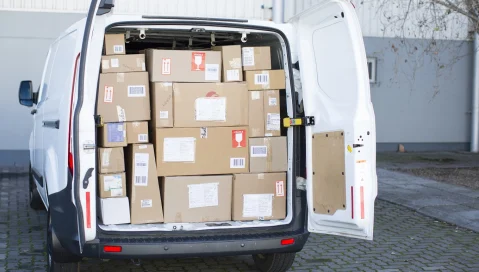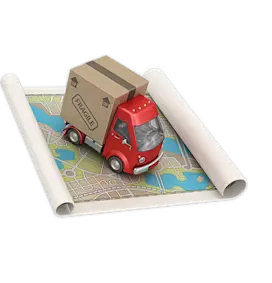Do You Need Business Route Planning Software? Here's How You Can Tell
Do You Need Business Route Planning Software? Here's How You Can Tell
Do You Need Business Route Planning Software? Here's How You Can Tell
8 Dez 2021
Jim Endres
The explosion of ecommerce means that transport and logistics companies should have a bright future. And you can position your transportation company to take advantage of this trend.
The question is—do you have the right tools to manage your fleet under the mounting burden of routes that have increased in both complexity and volume? We know that your team is under pressure. The “Amazon Effect” means that you must deliver everything faster and with tighter time windows.
Some fleet managers try to meet this challenge by adding new trucks and drivers to the mix. While this seems like a good solution at first, if you cannot create intelligent, efficient routes with the vehicles you have, you certainly won’t be able to do so once you add more vehicles. Adding more trucks when you don’t need to just eats into your profits and holds back growth. A better solution is to utilize the resources you do have in the most efficient way possible.
It all comes down to intelligent asset utilization.
If you’re using Google Maps or Waze to manage your routes, and your team is struggling to meet delivery deadlines, it might be time to consider upgrading your routing software. While routing software is an investment, it’s cheaper than putting a new truck on the road. And unlike a new truck, business route planning software will get you a solid return on investment (ROI) within six months.
If you’re unsure about whether to pull the trigger on purchasing business route planning software, we’ve compiled a list of telltale signs that your logistics company needs to make the switch below. And, if you still have questions, you can check out our comprehensive guide to route planning software: Route Planning Software 101: What Is It? And Why Do All Fleet Operators Need It?
1. You’re Not Meeting Customer Expectations
The “Amazonization” of logistics has left no industry untouched. Retailers must offer similar service levels to compete and even B2B companies now find themselves subject to tighter delivery requirements as consumers bring their adjusted expectations into their working lives. Whether your fleet is delivering your own products, or distributing on behalf of other brands, these higher delivery expectations fall squarely on the shoulders of the transportation department.
In addition, with online reviews, missing a promised delivery window can be catastrophic. Not only could you face a disastrous online review, but your customer might cancel their contract with you if the delivery was important for their business operations.
Granted, accidents happen, and even Amazon’s drivers run late sometimes. But the key to keeping your customers happy is being able to meet delivery times the majority of the time and giving them full visibility into their orders. Sure, they might still be upset if their order runs late, but if they know about it ahead of time both of you can plan accordingly. Furthermore, if you know about the delays, your service team can contact the customer immediately and avoid an angry WISMO (Where’s My Order) call.
Maybe you have clients that want more flexibility in their delivery times. If you can’t offer early-morning or late evening times, you might not be able to retain them. If your planning process takes hours, you’re forced to set deadlines for processing customer orders earlier. You’d like to offer different time slots and up the ante on your customer service, but you cannot seem to find the resources.
You need to keep your market share, but if your competitors can offer two-hour time slots, later delivery cut-off times and consistently meet customer demands, you might be in trouble if you cannot do the same. It may be time to rethink your manual route planning processes.
Automated business route planning software lets you organize your daily routes with tighter time constraints. This means that you can finally offer flexible scheduling and keep ALL your customers happy. With manual spreadsheets or basic online tools, you’re tied up creating and adjusting route plans for hours. Advanced route optimization systems take all your variables and create feasible routes in minutes. This means you can plan later in the day, offering later order cut-off times to your customers without sacrificing the granularity of time windows they require.
2. Your Drivers Aren’t Happy
It’s no secret that we are in a worldwide shortage of qualified truck drivers. Good drivers are leaving their current jobs, lured by the promise of higher salaries and large signing bonuses. You care about your drivers, and you want to give them equitable, feasible shifts that end on time. You want to keep your drivers, and you want them to enjoy working for you. But if you are hearing complaints from even your veteran drivers, it’s time to look at how efficient your current operation really is.
When you plan your routes manually, several issues can arise.
Drivers are constantly working overtime because of unplanned delays.
Drivers often complain about favoritism.
You’re doing things the way you’ve always done them, without considering driver’s skills or preferences.
Your planning time often takes longer than running the actual routes.
Unfortunately, if you’re still using manual planning process or basic software that cannot account for driver attributes, these issues might never get resolved. Your drivers have been frustrated due to inconsistent schedules. Your trucks haven’t been running with full capacity. Often, you’ve had to miss deliveries due to Hour of Service restrictions or unexpected delays.
Business route planning software ensures you make the most of your current resources because it optimizes delivery schedules, vehicle capacity and driver utilization. You also can test myriad “what-if” scenarios and find ways to become even more efficient. Business routing software lets you model the possible effects of proposed changes, like changing truck sizes, or multi-stop routes. Using a virtual simulation, you’ll see how these changes would affect your team before you try to implement them.
3. You Don’t Know Your Operating Costs
If someone walked up to you tomorrow and asked you something like, “Customer XYZ wants to add two more weekly deliveries. Can we do it?”
Would you know how to answer them? Would you be able to ensure the decision was profitable for your business? If you hesitated for even a second, you could use advanced business route planning software.
If you still plan routes manually, or are using tools like Google Maps or Waze, you can’t answer these questions. Google Maps is handy for the average commuter, but it cannot give you information on cost-to-serve data. If you are trying to use spreadsheets to calculate your cost to serve, the data would be tentative at best, or non-existent. So how can you know, down to the penny, if a schedule change or taking on a new customer will be profitable?
It seems simple—new business is a good thing. But if you don’t know the daily costs of your operation, you might not be able to take on additional stops for Customer XYZ without curtailing service to another customer.
With advanced business routing software, you’ll gain a granular understanding of costs. You ‘ll know every KPI you need, including cost per drop, cost per mile, or even the cost to service individual customers. You’ll be able to control costs and can constantly find ways to improve.
In addition, business routing software helps you avoid unnecessary capital expenditures. Let’s say you thought about adding new trucks to the fleet because you’re growing quickly. If you cannot do a comprehensive resource and efficiency analysis, you might add trucks or drivers you don’t need. Maybe you’ve added a graveyard shift at your warehouse because you are trying to meet increasing customer demand. Business routing software will scrutinize all possible scenarios and let you know if the new strategy you’re planning is the right move.
Asset utilization is a key ratio for every business. For a growing transport business, fleet efficiency is imperative, and most of your company’s assets are tied to your trucks. As you grow, you want fleet costs to decrease and your revenue to increase. But if you’re still using Google Maps and spreadsheets for your route plans, you may never see that golden ratio.
If you haven’t thought about it yet, now is the time to consider business route planning software. It does more than create efficiencies and help with driver retention—it will help you save money every day. It future proofs your company because it helps you improve the bottom line.
If you’re currently planning routes manually or using basic tools, introducing business route planning software should lead to a 10–30% reduction in fleet operating costs, overall. It works by making better use of your assets and resources, which saves you money, because a more efficient fleet means using fewer trucks and drivers. You can expect to see an ROI between 3 and 12 months.
Don't take our word for it. Read the following success stories from actual customers:
Dreams Enables 12,000 Home Deliveries a Week with Aptean Home Delivery
Martin Brower Keeps the Burgers Rolling in the USA with Aptean Routing & Scheduling
Aptean Routing & Scheduling Software Helps Tesco Cut Carbon Emissions
Aptean Routing & Scheduling Helps AKI Group Improve Productivity and Reduce Costs
Or check out our list of fleet route planning software frequently asked questions to get all the information you need about this transformative software.
Ready to get started supercharging your logistics operation? Our team of route optimization experts can use existing data from your company and perform a diagnosis of your route planning operations. We’ll show you the savings and performance improvements you could gain. Find out how, now.
Sind Sie bereit, Ihr Unternehmen grundlegend zu verändern?
Wir bieten Ihnen die spezialisierten TMS-Lösungen, die Sie für die Herausforderungen Ihrer Branche benötigen.



